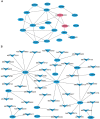Photoperiod induced the pituitary differential regulation of lncRNAs and mRNAs related to reproduction in sheep
- PMID: 33976954
- PMCID: PMC8067910
- DOI: 10.7717/peerj.10953
Photoperiod induced the pituitary differential regulation of lncRNAs and mRNAs related to reproduction in sheep
Abstract
The pituitary is a vital endocrine organ that regulates animal seasonal reproduction by controlling the synthesis and secretion of the hormone. The change of photoperiod is the key factor affecting the function of the pituitary in animals, but the mechanism is unclear. Here, we studied the transcriptomic variation in pars distalis (PD) of the pituitary between short photoperiod (SP) and long photoperiod (LP) using RNA sequencing based on the OVX+E2 sheep. 346 differentially expressed (DE) lncRNAs and 186 DE-mRNA were found in the PD. Moreover, function annotation analysis indicated that the reproductive hormones and photoperiod response-related pathways including aldosterone synthesis and secretion, insulin secretion, thyroid hormone synthesis, and circadian entrainment were enriched. The interaction analysis of mRNA-lncRNA suggested that MSTRG.240648, MSTRG.85500, MSTRG.32448, and MSTRG.304959 targeted CREB3L1 and DUSP6, which may be involved in the photoperiodic regulation of the PD. These findings provide resources for further study on the seasonal reproductive in ewes.
Keywords: Photoperiod; Pituitary; RNA sequencing; Sheep; lncRNA; mRNA.
©2021 He et al.
Conflict of interest statement
The authors declare there are no competing interests.
Figures





Similar articles
-
Transcriptome Analysis Revealed Long Non-Coding RNAs Associated with mRNAs in Sheep Thyroid Gland under Different Photoperiods.Genes (Basel). 2022 Mar 28;13(4):606. doi: 10.3390/genes13040606. Genes (Basel). 2022. PMID: 35456411 Free PMC article.
-
Transcriptomic Changes of Photoperiodic Response in the Hypothalamus Were Identified in Ovariectomized and Estradiol-Treated Sheep.Front Mol Biosci. 2022 Apr 11;9:848144. doi: 10.3389/fmolb.2022.848144. eCollection 2022. Front Mol Biosci. 2022. PMID: 35480892 Free PMC article.
-
Identification of Photoperiod-Induced LncRNAs and mRNAs in Pituitary Pars Tuberalis of Sheep.Front Vet Sci. 2021 Aug 3;8:644474. doi: 10.3389/fvets.2021.644474. eCollection 2021. Front Vet Sci. 2021. PMID: 34414222 Free PMC article.
-
Thyroid hormone and seasonal regulation of reproduction.Front Neuroendocrinol. 2013 Aug;34(3):157-66. doi: 10.1016/j.yfrne.2013.04.002. Epub 2013 May 6. Front Neuroendocrinol. 2013. PMID: 23660390 Review.
-
Signaling pathways to and from the hypophysial pars tuberalis, an important center for the control of seasonal rhythms.Gen Comp Endocrinol. 2018 Mar 1;258:236-243. doi: 10.1016/j.ygcen.2017.05.011. Epub 2017 May 13. Gen Comp Endocrinol. 2018. PMID: 28511899 Review.
Cited by
-
Comparative Transcriptomics Reveals the Key lncRNA and mRNA of Sunite Sheep Adrenal Gland Affecting Seasonal Reproduction.Front Vet Sci. 2022 Apr 8;9:816241. doi: 10.3389/fvets.2022.816241. eCollection 2022. Front Vet Sci. 2022. PMID: 35464356 Free PMC article.
-
Transcriptome Analysis Revealed Long Non-Coding RNAs Associated with mRNAs in Sheep Thyroid Gland under Different Photoperiods.Genes (Basel). 2022 Mar 28;13(4):606. doi: 10.3390/genes13040606. Genes (Basel). 2022. PMID: 35456411 Free PMC article.
-
Identification of photoperiod-induced specific miRNAs in the adrenal glands of Sunite sheep (Ovis aries).Front Vet Sci. 2022 Jul 22;9:888207. doi: 10.3389/fvets.2022.888207. eCollection 2022. Front Vet Sci. 2022. PMID: 35937294 Free PMC article.
-
Circadian Synchrony: Sleep, Nutrition, and Physical Activity.Front Netw Physiol. 2021 Oct;1:732243. doi: 10.3389/fnetp.2021.732243. Epub 2021 Oct 12. Front Netw Physiol. 2021. PMID: 35156088 Free PMC article.
-
Transcriptomic Changes of Photoperiodic Response in the Hypothalamus Were Identified in Ovariectomized and Estradiol-Treated Sheep.Front Mol Biosci. 2022 Apr 11;9:848144. doi: 10.3389/fmolb.2022.848144. eCollection 2022. Front Mol Biosci. 2022. PMID: 35480892 Free PMC article.
References
-
- Buffet C, Hecale-Perlemoine K, Bricaire L, Dumont F, Baudry C, Tissier F, Bertherat J, Cochand-Priollet B, Raffin-Sanson M, Cormier F, Groussin L. DUSP5 and DUSP6, two ERK specific phosphatases, are markers of a higher MAPK signaling activation in BRAF mutated thyroid cancers. PLOS ONE. 2017;12(9):e0184861. doi: 10.1371/journal.pone.0184861. - DOI - PMC - PubMed
LinkOut - more resources
Full Text Sources
Other Literature Sources
Miscellaneous

